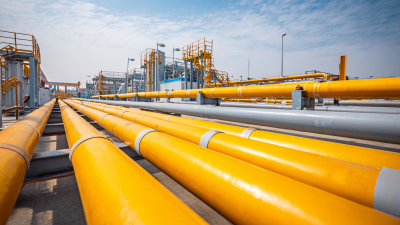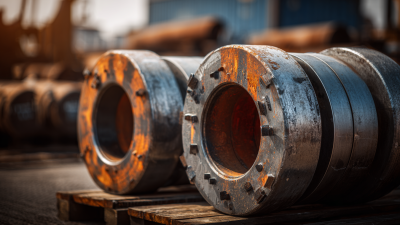Email Id: sale@adctooling.com
When it comes to ensuring the efficiency and reliability of piping systems, selecting the right components is crucial. PTFE pipe fittings have gained significant recognition in various industries due to their remarkable chemical resistance and temperature tolerance, making them ideal for applications in pharmaceuticals, food processing, and petrochemicals. According to a recent market research report by Freedonia Group, the demand for fluoropolymer products, including PTFE fittings, is projected to grow at an annual rate of over 5% through 2026, driven by an increasing focus on safety and compliance in hazardous environments. As such, understanding the key strategies for selecting the best PTFE pipe fittings is essential for project managers and engineers aiming to optimize their systems. This tutorial will guide you through the critical factors to consider, ensuring that your projects are equipped with high-performance fittings that stand the test of time.

When it comes to project success, particularly in environments facing unique challenges like those in Rustenburg Local Municipality, understanding the importance of material selection in pipe fittings becomes crucial. PTFE, or polytetrafluoroethylene, offers substantial advantages in durability, chemical resistance, and temperature tolerance, making it an optimal choice for various applications. These properties ensure that PTFE pipe fittings can withstand harsh conditions and prevent leaks, thereby enhancing project efficiency and reliability—an essential factor for any construction or industrial project.
The selection of the right PTFE pipe fittings requires careful consideration of project specifications and stakeholder engagement. By involving relevant parties early in the decision-making process, project managers can better understand operational needs and environmental challenges. This collaborative approach not only helps ensure the proper materials are chosen, but it also fosters a sense of ownership and accountability among stakeholders. In a locale grappling with water issues exacerbated by extensive mining activities, utilizing PTFE pipe fittings can significantly contribute to mitigating operational disruptions and ensuring a sustainable water supply, ultimately paving the way for project success.
When selecting PTFE pipe fittings for your projects, several key factors must be taken into account to ensure optimal performance and reliability. First and foremost, the chemical compatibility of PTFE with the substances it will transport is critical. A report by the Chemical Resistance Guide published by the Plastics Pipe Institute indicates that PTFE exhibits outstanding resistance to a wide range of chemicals, including acids, alkalis, and solvents. This makes PTFE fittings ideal for challenging applications, particularly in the chemical and pharmaceutical industries.
Another vital consideration is temperature and pressure ratings. According to the ASTM (American Society for Testing and Materials), PTFE can withstand temperatures up to 260°C (500°F) and maintains its structural integrity under significant pressure conditions. This makes it suitable for high-temperature systems typical in manufacturing processes. Ensuring that the selected fittings meet your specific temperature and pressure needs is essential to prevent failures and ensure a long service life.
Finally, sizing and fitting standards should not be overlooked. The right dimensions and compatibility with existing piping systems are crucial for seamless integration. Data from the International Association of Plumbing and Mechanical Officials (IAPMO) suggests that improper sizing can lead to flow restrictions, increased friction, and hydraulic inefficiencies, ultimately impacting system performance. By considering these factors carefully, you can ensure that you are choosing the best PTFE pipe fittings for your specific application.
| Factor | Description | Importance Level | Common Applications |
|---|---|---|---|
| Material Quality | Ensure fittings are made from high-quality PTFE for durability and resistance. | High | Chemical processing, pharmaceuticals |
| Size Compatibility | Fittings must match piping dimensions for effective sealing. | Medium | Water systems, hydraulic applications |
| Pressure Rating | Select fittings that can withstand system pressure requirements. | High | Oil and gas, industrial processes |
| Temperature Tolerance | Choose fittings that accommodate the intended operating temperature. | Medium | High-temperature applications |
| Seal Type | Consider the ideal type of seal (compression, threaded, etc.) for your connection. | High | Aerospace, automotive |
When selecting the right PTFE pipe fittings for your projects, it's essential to understand the various types available and their intended applications. PTFE fittings are renowned for their chemical resistance and thermal stability, making them ideal for industries such as pharmaceuticals, food processing, and chemical manufacturing. When comparing types, consider both the pressure ratings and compatibility with different media to ensure optimal performance.
Tip: Always check the specifications of each fitting type, such as compression fittings, flanges, or unions, to determine which design best suits your system. For high-temperature applications, you may want to opt for fittings specifically rated for elevated heat levels, as standard PTFE might not withstand extreme conditions.
Moreover, consider the installation process of each fitting type. Some may require special tools or techniques which can influence your project timeline and labor costs.
Tip: Make sure to consult manufacturer guidelines for installation instructions, as proper fitting installation can significantly impact the performance and longevity of your piping system. It's also advisable to enlist the help of an experienced professional if you're tackling complex systems.
When it comes to selecting reliable PTFE pipe fittings for your projects, the choice of brands and manufacturers can significantly impact overall performance and safety. Notably, the growing awareness regarding PFAS (per- and polyfluoroalkyl substances) in various applications, including plumber's tape, has raised concerns about potential interactions with drinking water. While further research is warranted, it emphasizes the need to choose suppliers who prioritize safety and compliance with health regulations.
The market for semiconductor tubing and fittings is also expanding, with size exceeding USD 9.9 billion in 2024, projected to grow at a CAGR of 8.5% from 2025 onwards. This growth highlights the increasing demand for high-quality and durable materials, making brand selection even more critical. When sourcing PTFE fittings, consider industry leaders known for rigorous testing and adherence to standards that ensure your project's integrity.
Tips: Always verify that the manufacturer provides certifications and test results for their products. Look for brands that are transparent about their material sourcing and production processes. Engaging with suppliers who have a strong reputation in the market can further mitigate risks associated with material quality.

When selecting PTFE pipe fittings for your projects, one of the most common mistakes is overlooking the specific requirements of your application. Many engineers fail to consider the temperature and pressure ratings associated with different PTFE grades. According to the "PTFE Polymer Market Research Report" by Grand View Research, PTFE can withstand temperatures up to 260°C (500°F), but not all fittings are rated for such extremes. A mismatch can lead to degradation or failure, impacting system reliability and safety.
Another frequent error is ignoring compatibility with other materials. PTFE is highly chemically resistant, yet when paired with incompatible metals, issues such as galvanic corrosion can arise. A comprehensive chemical resistance chart, such as those provided by the Plastic Pipe Institute, should be referenced to ensure compatibility. Furthermore, neglecting the fitting sizes and configurations can result in leaks or reduced flow efficiency, as reported by the American Society of Mechanical Engineers (ASME) in their standards for pipe fitting applications. Paying close attention to these factors can significantly enhance the performance and longevity of your piping systems.






